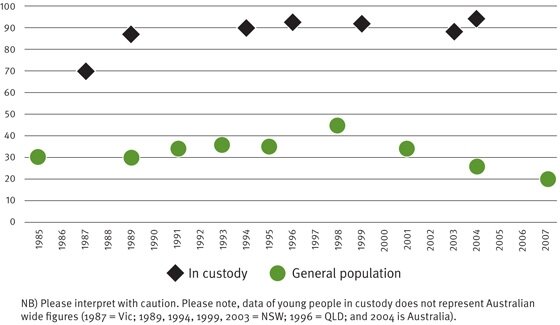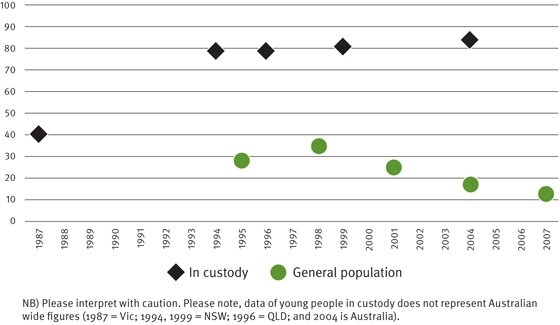Bulletin 5
The need to monitor and reduce cannabis use among young offenders
Published January 2009
Melanie Simpson, John Howard, Jan Copeland & Anthony Arcuri.
Key points
- Young offenders are continuing to use cannabis at extremely high rates despite a recent decline in use among young people in the general population
- Both experimentation and regular use of cannabis occur at a much younger age among those who spend time in custody
- Young offenders are at increased risk of developing problems associated with heavy and frequent cannabis use
- There is a need for more focused intervention and preventative efforts among this group in order to address the unabated high levels of cannabis use, crime and associated risk behaviours
- Regular monitoring of substance use trends and associated behaviours in juvenile justice settings can establish an evidence base which can inform targeted primary and secondary interventions
Introduction
Although cannabis remains the most widely used illicit drug in Australia, cannabis use among adolescents in the general community aged 14-19 years in the past 12 months has reduced significantly.1 This trend of reducing cannabis use among young people, however, is not replicated among young offenders who spend time in detention facilities.
Young people who are involved in the criminal justice system in Australia tend to be characterised as having backgrounds of risk and vulnerability. Many come from situations of economic disadvantage, parental imprisonment and substance use and are more likely to be disengaged from education, training and employment.2, 3 Regular participation in a range of risk-taking and thrill-seeking behaviours; particularly in relation to substance use is also common among this group.2
Both international and Australian research has found that young offenders tend to experiment with, and begin using regularly, both licit and illicit substances at a much younger age than non-offending youth.4-7 Such earlier onset of licit and illicit substance use is associated with increased harm, such as continued and escalating use of illicit substances, higher prevalence of substance use disorders, engagement in multiple health risk behaviours, increased criminal activity and more frequent and longer periods of incarceration.5, 8-11
Prevalence of cannabis use among young people in custody
The substance use trends and patterns of use among incarcerated young people in Australia have not been routinely collected over time, nor is this population included in routine community health surveys.12 There have, however, been some surveys conducted and the results published in an attempt to understand such patterns of use and related harms among this group. Most of these surveys though, have employed differing methodologies and lack standardization of questions related to substance use and risk behaviours, this in turn makes direct comparisons between them and national surveys difficult. That said, data that are available are of significant interest for both policy and program development.
Figure 1 compares the proportions of lifetime cannabis use between young people in custody and those in the general population, using available data.1, 3, 4, 7, 13- 23 It is evident that almost all adolescents who spend time in custody have tried cannabis at some stage in their life and this trend appears to have remained quite stable over time. In contrast, cannabis use among the general population of the same age group has been steadily decreasing since 1998.
Figure 1
Lifetime cannabis use among adolescents (%)

When plotting recent use of cannabis among the two groups mentioned above, a similar picture is found (Figure 2). While the recall period for young people in the general population was 12 months prior to interview and 1 month prior to custody for young offenders, this may still suggest that young offenders were much more likely to have recently used cannabis than young people in the general Australian population. Even though young people may increase their offending and cannabis use immediately prior to entering custody (which could inflate estimates of their levels of recent use), these statistics appear to support research suggesting that frequent cannabis use is strongly associated with juvenile crime.
Figure 2
Recent cannabis use among adolescents (%)

The previous two graphs, although limited in a number of ways, present a clear difference between the cannabis use patterns of young people who spend time in detention and those in the general community, and thus reinforces the need for more focused interventions and preventative efforts to address cannabis use, associated crime and risk behaviours among young people who spend time in juvenile detention facilities. This point is further strengthened when cannabis use among adolescents who are taken into police custody is examined. It is evident when looking at the Drug Use Monitoring Australia (DUMA) data, that although levels of cannabis use among this group remains high, there has been an overall decline in the number of police detainees testing positive to cannabis between 1999 and 2007; mirroring what has occurred in the general community.24
Associated risks of use among this population
Cannabis is often misrepresented as a ‘soft drug’, but the possible harms associated with its use are now well recognized. For high-risk young people, who initiate heavy and frequent cannabis use at an early age, multiple harms and associated problem behaviours are likely to emerge. The settings within which young offenders enact their lives and engage in crime and recreation often overlap with those who are older and more entrenched in their illegal activities. Consequently, such young people may adopt behaviours, for example the use of and patterns of use of specific illicit substances, less common in other youthful populations.
The general health risks and harms associated with cannabis use are well documented and therefore will not be discussed in full detail here. Cannabis use among young offenders, however, has been linked to increased risk of criminal offending; increased likelihood of progression to other illicit substances and poly-drug use; risky substance use and risky sexual behaviours.3, 9, 25, 26 Regular monitoring of this sentinel population, therefore, can be a useful way of keeping abreast of trends in substance use and risk behaviors, which can in turn, inform programs and prevention interventions in their efforts to reduce both substance use and offending among these young people.
Addressing cannabis use and associated risks among young offenders
Why is cannabis use, in particular recent use, decreasing among the general population but remaining at high levels among young offenders? There are perhaps a number of explanations for this, including the following:
- current public health messages about cannabis and other illicit substances are not reaching or appealing to this group;
- cannabis use forms part of a cluster of delinquent behaviours that these youth engage in; and
- cannabis is virtually ‘normalised’ in the peer and even family environments within which young offenders spend much of their time.
Whatever the contributors, high levels of cannabis use among this sub-section of the population remains problematic and requires greater attention.
Although the number of young people in detention across Australia has fluctuated over the years, there has been an increase in the total number of young people spending time in detention across some states, including a 12% increase in recorded numbers for NSW between 2003-04 and 2006-07.27, 28 Such increases can test the capacity of juvenile justice facilities in some states to accommodate and meet the complex needs of those incarcerated within them. Any reduction in juvenile offending leading to fewer arrests and fewer young people being placed in custody makes sense – both in terms of social wellbeing and the economic burden of providing correctional facilities that may achieve little in the way of ‘correction’.29
Having better, timely and more reliable data with which to sharpen the thrust of efforts by those working with young offenders to reduce drug use and related harms and routinely available motivational and skills-based interventions may play a role in the reduction of recidivism related to heavy, regular cannabis use among this group.
References
- Australian Institute of Health and Welfare. (2008). 2007 National Drug Strategy Household Survey: First Results. Canberra: Australian Institute of Health and Welfare.
- Kenny, D. & Nelson, P. (2008). Young Offenders on Community Orders: Health, Welfare and Criminogenic Needs. Sydney: Sydney University Press.
- NSW Department of Juvenile Justice. (2003). 2003 NSW Young People in Custody Health Survey: Key findings report. Sydney: NSW Department of Juvenile Justice.
- Copeland, J., Howard, J., Keogh, T., & Seidler, K. (2003). Patterns and correlates of substance use among juvenile detainees in New South Wales 1989-99. Drug and Alcohol Review 22, 15-20.
- Dembo, R., Williams, L., Getreu, A., Genung, L., Schmeidler, J., Berry, E., Wish, E., & La Voi, L.(1991). Longitudinal study of the relationship among marijuana/hashish use, cocaine use, and delinquency in a cohort of high risk youths. Journal of Drug Issues 21, 271-312.
- Johnson, D. (2001). Age of illicit drug initiation. Trends and Issues in Crime and Criminal Justice 201. Canberra: Australian Institute of Criminology.
- Prichard, J. & Payne, J. (2005). Alcohol, drugs and crime: A study of juveniles in detention. Research and Public Policy Series 67. Canberra: Australian Institute of Criminology.
- D’Amico, E., Edelen, M., Miles, J., & Morral, A. (2008). The longitudinal association between substance use and delinquency among high-risk youth. Drug and Alcohol Dependence 93, 85-92.
- DuRant, R., Smith, J., Krieter, S., & Krowchuk, D. (1999). The relationship between early age of onset of initial substance use and engaging in multiple health risk behaviors among young adolescents.Archives of Pediatrics and Adolescent Medicine 153, 286-290.
- Slade, E., Stuart, E., Salkever, D., Karakus, M., Green, K., & Ialongo, N. (2008). Impacts of age of onset of substance use disorders on risk of adult incarceration among disadvantaged urban youth: A propensity score matching approach. Drug and Alcohol Dependence 95, 1-13.
- Zhang, L., Wieczorek, W. & Welte, J. (1997). The impact of age of onset of substance use on delinquency. Journal of Research in Crime and Delinquency 34, 253-268.
- Australian Institute of Health and Welfare. (2006). Towards a National Prisoner Health Information System. Canberra: Australian Institute of Health and Welfare.
- Australian Institute of Health and Welfare. (1999). National Drug Strategy Household Survey: Technical Report 1998. Canberra: Australian Institute of Health and Welfare.
- Australian Institute of Health and Welfare. (2002). 2001 National Drug Strategy Household Survey: Detailed Findings. Canberra: Australian Institute of Health and Welfare.
- Australian Institute of Health and Welfare. (2004). 2004 National Drug Strategy Household Survey: First Results. Canberra: Australian Institute of Health and Welfare.
- Commonwealth Department of Community Services and Health. (1990). Statistics on Drug Abuse in Australia 1989. Canberra: Commonwealth Department of Community Services and Health.
- Commonwealth Department of Health, Local Government and Community Services. (1993). National Drug Household Survey. Canberra: Commonwealth Department of Health, Local Government and Community Services.
- Crundall, I. (1987). Survey of Drug Use Among Young People in Victorian Youth Training and Reception Centres. Alcohol and Drug Services Unit: Health Department Victoria.
- Hando, J., Howard, J. & Zibert, E. (1997). Risky drug practices and treatment needs of youth detained in New South Wales Juvenile Justice Centres. Drug and Alcohol Review 16, 137-145.
- Howard, J. & Zibert, E. (1990). Curious, bored and wanting to feel good: The drug use of detained young offenders. Drug and Alcohol Review 9, 225-231.
- Lennings, C. & Pritchard, M. (1999). Prevalence of drug use prior to detention among residents of youth detention centres in Queensland. Drug and Alcohol Review 18, 145-152.
- Putnins, A. (1995). Recent drug use and suicidal behavior among young offenders. Drug and Alcohol Review 14, 151-158.
- Reid, A., Lynskey, M. & Copeland, J. (2000). Cannabis use among Australian adolescents: Findings of the 1998 National Drug Strategy Household Survey. Australian and New Zealand Journal of Public Health 24, 596-602.
-
Australian Institute of Criminology. (2008). Drugs and Offending Online interactive data tool, accessed 18/12/2008,
- Kandel, D. & Yamaguchi, K. (1993). From beer to crack: Developmental patterns of drug involvement.American Journal of Public Health 83, 851-855.
- Kingree, J. & Phan, D. (2002). Marijuana use and unprotected sexual intercourse among adolescent detainees. Criminal Justice and Behavior 29, 705-717.
- Australian Institute of Health and Welfare. (2008). Juvenile justice in Australia 2006-07. Juvenile Justice Series 4. Canberra: Australian Institute of Health and Welfare.
- Taylor, N. (2007). Juveniles in detention in Australia, 1981-2006. Technical and Background Paper 26. Canberra: Australian Institute of Criminology.
- Weatherburn, D., Cush, R. & Saunders, P. (2007). Screening juvenile offenders for further assessment and intervention. Crime and Justice Bulletin 109. Sydney: NSW Bureau of Crime Statistics and Research.













































